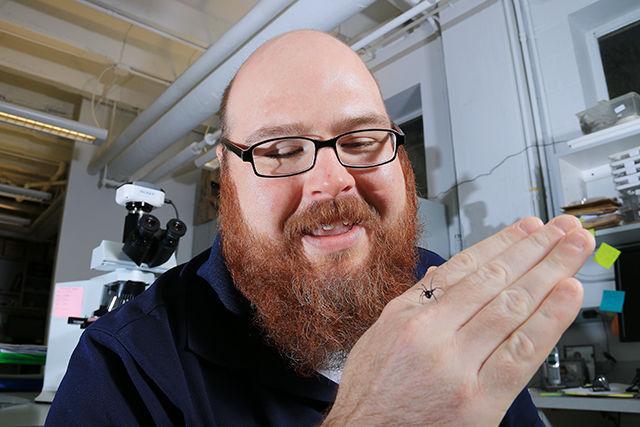You’re leaning against a wall when suddenly you feel a sharp pain on your shoulder. There’s a red welt forming and on the wall is a crushed small brown insect. It looks like a spider to you but you’re not quite sure. Your arm hurts, but is it just the pain from the bite, or something more serious? What do you do? Who do you call?
Right here on campus, tucked inside the basement of Gardner Hall, is the resource you need. The NC State Plant Disease and Insect Clinic is a service on campus that specializes in identifying plant diseases, pest problems and yes, bites from creepy crawlies.
At the heart of the insect section of the lab is entomologist Matt Bertone. Bertone has been with the clinic for over two years and is an expert in insects. He has studied all sort of insects and a huge part of his work is in taxonomy, the identification of organisms.
“I deal a lot with homeowners, indoor pests, things like that,” Bertone said. “Basically if you have some sort of organism that is causing some kind of issue or you’re curious about it, send us photos of it or send in a sample of it and we’ll identify what it is.”
Bertone is an expert in all sorts of different insects, from flies and beetles, the main insects he studies, to worms, caterpillars and spiders. His desk is littered with myriad different insects, preserved in little plastic containers filled with dry alcohol, which Bertone says is a great way to preserve the tiny little bodies.
“I’ve always been interested in insects and arachnids since I was five or even younger,” Bertone said. “I really like the variety of arthropods, I mean we’re talking about a million different species across the world. There are so many amazing things about these organisms that it’s impossible to get bored.”
Bertone has identified insect bites for gardeners, farmers and anybody else who might get bitten.
“Identifying bites is difficult,” Bertone said. “That’s one thing most entomologists can agree on. A venomous bite from an organism can cause a person to react in various different ways. It could also be a dry bite or a bite with no venom in it.”
Bertone said that instead of trying to identify a bite based off of the physical bite itself, the bite is often identified much more easily by identifying the body of the organism that made the bite. Identifying the dead insect helps to evaluate the severity of the situation and decide what should be done with the bite victim next.
“If you have a bite where you feel pain while putting on your shoe and you find a crushed spider then we have a body to identify,” Bertone said.
As part of this job, Bertone sometimes has to identify spiders.
Bertone says that it is very rare for spiders to bite because most spiders are not aggressive. The brown recluse, one of the most feared spiders in North Carolina, gets its name from its reclusive nature.
“Very rarely are there deaths associated with them [spiders],” Bertone said. “You’re more likely to die from a vending machine falling on you or from a lightning strike than from a spider bite.”
Bertone said that he would rather be bitten by a brown recluse than a black widow, the other deadly spider found in North Carolina, because a black widow’s venom causes terrible pain that can last for several days.
“But your chances of dying are very low,” said Bertone. “It’s [a black widow’s bite] a very painful thing to have but you come out all right in most cases.”
Bertone said that the brown recluse’s venom has a chance to cause a lesions where the skin around the bite dissolves. This is extremely rare, however, and it happens in less than twenty percent of cases, despite being one of the main reasons the spider is so greatly feared.
“There are a few spiders around the world and certain types of spiders around here [North Carolina] that, if you get in their way, will rear up and show their fangs, such as trapdoor spiders,” Bertone said. “Typically it’s the males [trapdoor spiders] that are going out, trying to find a mate. They are one-minded and if you get in one’s way it will rear up and not run away.”
Bertone said this behavior is a warning and that the spider is not likely to attack unless further provoked. Most spiders simply hold their ground and show signs of aggression such as bristling their hairs or, for more exotic spiders not found in the U.S., flash bright colors on their bellies to warn people away. However, unlike the trapdoor spiders, there are certain spiders around the world that are more aggressive.
Bertone said that one of his favorite spiders is the spitting spider, a spider he says that most people don’t know exist.
Cousin to the brown recluse, a spitting spider is a species of spider with an additional set of silk glands inside it’s head. These silk glands are attached to their venom glands. The spider can eject venomous silk at their prey in 25 milliseconds, faster than the blink of a human eye.
Bertone talked about this spider and many others like it with great enthusiasm, while he picked up a plastic container from his desk containing a spitting spider specimen.
When asked what spiders were likely to be living on campus, Bertone said that he believed there were most likely cobweb spiders, common house spiders, false widows, cellar spiders, wolf spiders and the spitting spider.
“But it’s not like you’ll ever see one,” Bertone said.
As part of this work, Bertone identifies insect bites for gardeners, farmers and anybody else who might get bitten.









